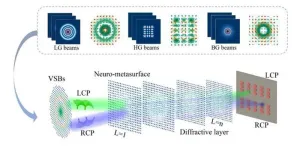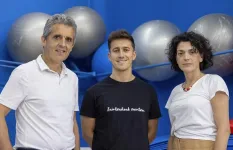(Press-News.org) BOSTON—Children who are sedentary for more than six waking hours a day have a significantly increased risk of severe fatty liver disease and liver cirrhosis by young adulthood, a new study finds. The research findings will be presented Saturday at ENDO 2024, the Endocrine Society’s annual meeting in Boston, Mass and published in Nature’s npj Gut and Liver.
“We found that this relationship between sedentariness and liver damage is likely causal,” said lead researcher Prof. Andrew Agbaje, M.D., M.P.H., Ph.D., of the University of Eastern Finland in Kuopio, Finland.
“The general public must be aware of this danger of sedentariness on the health of children, adolescents and young adults,” said Agbaje, who is also with the University of Exeter in Exeter, England. “Advanced fatty liver disease and liver cirrhosis, which is severe scarring and hardening of the liver, could increase the risk of future liver cancer or require a liver transplant.”
Fatty liver disease is a harmful fat buildup in the liver. When the condition is not due to alcohol consumption but linked to at least one of five components of metabolic syndrome, it is called metabolic-associated steatotic (fatty) liver disease (MASLD).
For this study, Agbaje analyzed data from a long-term study of a large U.K. birth cohort, called the Avon Longitudinal Study of Parents and Children (ALSPAC) or the “Children of the ’90s”. Included in this study were 2,684 children who had repeated measurements of their movements with a waist-worn accelerometer from ages 11 to 24 years. At ages 17 and 24, study participants underwent a liver ultrasound scan to assess for fatty liver and evidence of liver scarring. They also had bloodwork to measure their liver enzyme levels at those two timepoints.
On average, children from the study spent 6 hours a day sitting or otherwise being sedentary, but this time increased to 9 hours daily by young adulthood, the researcher found. In childhood, 6 hours per day was spent in light-intensity physical activity, which neutralized the deleterious effect of 6 hours per day spent sedentary.
For each half-hour of sedentary behavior above 6 hours per day, children had 15% higher odds of developing fatty liver disease before they were 25 years old. Any increase of sedentary time above 6 hours a day resulted in a corresponding decrease in the time spent in light-intensity physical activity, therefore 3 hours less daily by young adulthood. However, each additional half hour of light-intensity physical activity beyond 3 hours per day decreased the odds of severe fatty liver disease by 33%.
“We believe that this alteration in sedentary time versus time for light-intensity physical activity sets the stage for disease initiation and progression,” Agbaje said.
The prevalence of MASLD was 1 in 40 participants (2.5 percent) at age 17 and one in five participants (20 percent) at age 24. Agbaje called this finding surprising because the risk of MASLD increased eightfold in only seven years and because a 20 percent prevalence of the disease would usually not occur until one’s mid-40s.
Half of the 24-year-olds with MASLD had severe disease, or a significantly high amount of excess fat in the liver. One in every 40 young adults already had signs of liver scarring, with three in 1,000 young adults meeting the diagnostic criteria for liver cirrhosis, Agbaje reported.
However, he found that engaging in light-intensity physical activity for at least 3 hours a day reversed this premature liver damage. Each cumulative minute of moderate-to-vigorous physical activity in a day was associated with a slightly lower likelihood of severe MASLD at age 24 but was not associated with a lower likelihood of liver cirrhosis.
“The most effective antidote to the devastating health effects of childhood sedentariness is not the much-advertised moderate-to-vigorous physical activity of 60 minutes per day,” Agbaje said. “Rather, it is the overlooked light-intensity physical activity of 3 to 4 hours per day.”
Examples of light-intensity physical activity are outdoor games, playing at the playground, walking a dog, running errands for parents, or walking and biking.
This research received funding from the European Association for the Study of Obesity-Novo Nordisk Foundation New Investigator 2024 Award for Childhood Obesity, the Finnish Foundation for Cardiovascular Research and the Finnish Cultural Foundation.
# # #
Endocrinologists are at the core of solving the most pressing health problems of our time, from diabetes and obesity to infertility, bone health, and hormone-related cancers. The Endocrine Society is the world’s oldest and largest organization of scientists devoted to hormone research and physicians who care for people with hormone-related conditions.
The Society has more than 18,000 members, including scientists, physicians, educators, nurses and students in 122 countries. To learn more about the Society and the field of endocrinology, visit our site at www.endocrine.org. Follow us on Twitter at @TheEndoSociety and @EndoMedia.
END
WASHINGTON --- Clinicians at Georgetown University’s Lombardi Comprehensive Cancer Center reported promising preliminary findings based on outcomes in the first six patients with metastatic pancreatic cancer enrolled in a phase 2 clinical trial of the experimental drug BXCL701 in combination with the immunotherapy drug pembrolizumab (Keytruda). Immunotherapy drugs alone have not shown to be responsive to pancreatic cancer.
The findings were presented at the American Society of Clinical Oncology 2024 annual meeting in Chicago on June 1, 2024 (LBA4132).
BXCL701, made by BioXcel Therapeutics, is ...
Boston – Dana-Farber Cancer Institute researchers are leading 3 separate studies with encouraging results in treating patients with central nervous system (CNS) lymphoma, breast cancer, and glioblastoma. The studies support future research in these potential breakthroughs where treatment options may be limited. The research teams will present their findings at the 2024 Annual Meeting of the American Society of Clinical Oncology (ASCO) in Chicago, May 31-June 4, 2024. ASCO is the world’s largest clinical cancer research meeting, attracting more than 30,000 global oncology professionals.
These findings are among more than 80 studies presented at ASCO that ...
An Oregon-based program that monitors social media use may have helped deter more than 150 youth suicide attempts in the five years it’s operated, reports a new study published online today in the journal Psychiatric Services.
Staff with Lines for Life, a nonprofit that operates mental health crisis support services, and researchers at Oregon Health & Science University collaborated to closely document interventions by the Safe Social Spaces program, launched in 2019 by Lines for Life.
The study’s senior author said it’s an example of meeting people where they are.
“Community engagement is critical,” said Alan Teo, M.D., M.S., associate professor of ...
One of Earth’s most consequential bursts of biodiversity—a 30-million-year period of explosive evolutionary changes spawning innumerable new species—may have the most modest of creatures to thank for the vital stage in life’s history: worms.
The digging and burrowing of prehistoric worms and other invertebrates along ocean bottoms sparked a chain of events that released oxygen into the ocean and atmosphere and helped kick-start what is known as the Great Ordovician Biodiversification Event, roughly 480 million years ago, according ...
The recent surge in popularity of AI tools such as ChatGPT is forcing the science community to reckon with its place in scientific literature. Prestigious journals such as Science and Nature have attempted to restrict or prohibit AI use in submissions, but are finding it difficult to enforce because of how challenging it is becoming to detect machine-generated language.
Because AI is getting more advanced at mimicking human language, researchers at the University of Chicago were interested in learning ...
In the dynamic realm of optical physics, researchers are continually pushing the boundaries of how light can be manipulated and harnessed for practical applications. As reported in Advanced Photonics Nexus, a groundbreaking study from the Harbin Institute of Technology (HIT) introduces a method for sorting and distinguishing various types of vector structured beams (VSBs), promising significant advancements in optical communication and quantum computing.
Unlike conventional light beams that propagate in simple, straight trajectories, VSBs are engineered to form complex, intricate patterns. These beams transmit ...
Mainly older and middle-aged women, working class, with a very high prevalence of lower back pain and consequently possible psycho-affective problems and a poorer quality of life... This is the general profile of carers of the elderly. Who cares for the carer? This question or demand is not new in our society. Members of the Ageing On research group of the University of the Basque Country (UPV/EHU) asked themselves the following question: “How can we care for the carers?”
The Ageing On group develops, ...
Polygenic risk scores (PRSs) are estimates of an individual’s susceptibility to a specific complex trait obtained by aggregating the effects of dozens, thousands, and potentially millions of genetic variants associated with that specific trait into a single figure. Some private companies now market PRS embryo screening to prospective parents through the use of in vitro fertilisation and pre-implantation genetic testing. While PRS has great potential for prediction in live-born (mostly adult) individuals, its accuracy ...
Berlin, Germany: Cancer is the leading cause of disease-related death in children in most developed countries, and at least a quarter of these patients are diagnosed with aggressive high-risk or relapsed cancers, with an expected five-year survival rate of less than 30%. Accurate diagnosis can be difficult, and survivors often suffer life-long side effects because of the toxic treatments needed to cure them. Now, researchers from Australia have shown that, by using precision medicine*, it is possible not only to obtain more accurate diagnoses, but also that using precision-guided, targeted treatments earlier improves the two year progression-free ...
In May 2022, the Facility for Rare Isotope Beams (FRIB) at Michigan State University (MSU), launched its precision measurement program. Staff from FRIB’s Low Energy Beam and Ion Trap (LEBIT) facility take high-energy, rare-isotope beams generated at FRIB and cool them to a lower energy state. Afterward, the researchers measure specific particles’ masses at high precision.
The LEBIT team, led by Ryan Ringle, adjunct professor of physics at FRIB and in the MSU Department of Physics and Astronomy and senior ...



